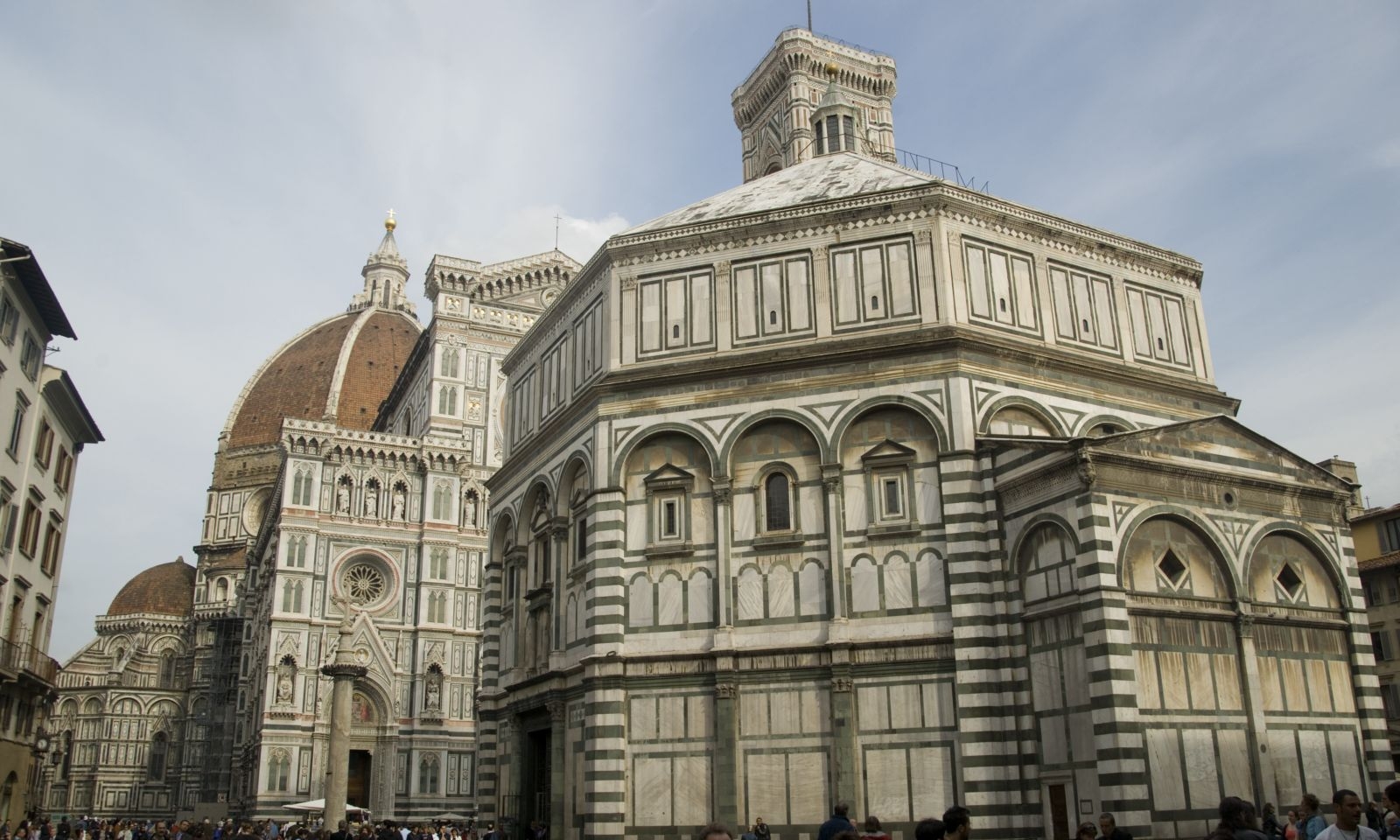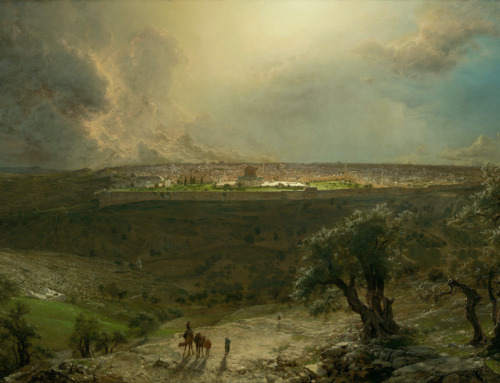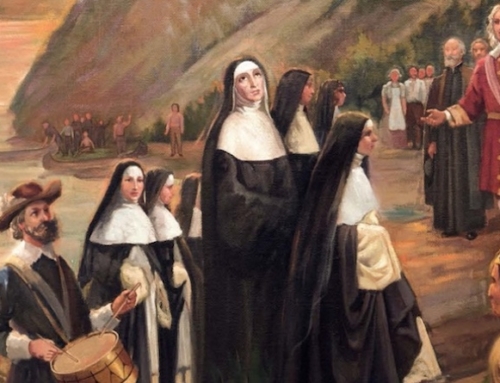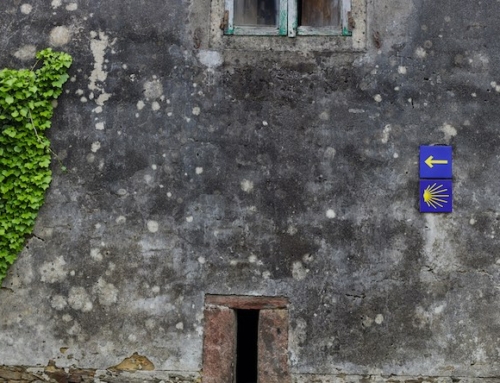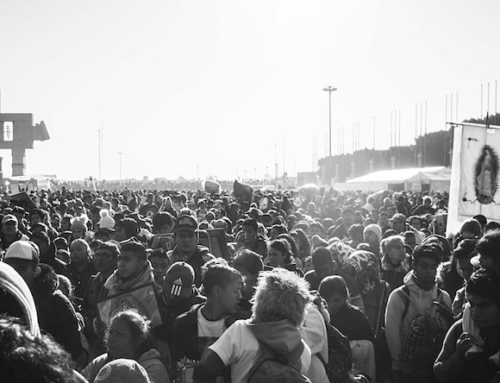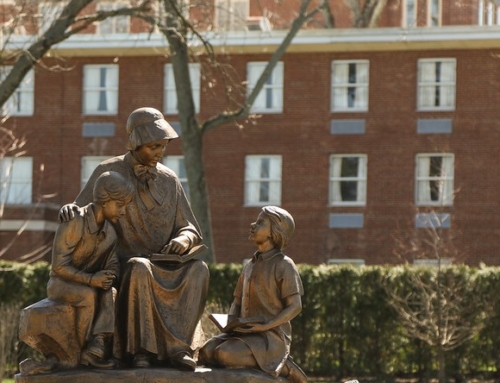The Sights and Sounds of Christmas:
The Baptistery of San Giovanni in Florence, c. 1059-1128
The Baptistery of San Giovanni in Florence rises before the great dome of Brunelleschi and the front doors of the cathedral. This structure, separate from the Duomo, envelops the place where God tears open the heavens for the soul who receives the graces of baptism.
The Florentines constructed the Romanesque structure in the eleventh and twelfth centuries during an economic boom. The people—enjoying temporal benefits from God—gave thanks by means of ordered geometry, carved stone, and gilded mosaics. Guided by faith, human hands lifted up this baptistery as an invitation for the Lord to come down and reign in the city of Florence. Pope Nicholas II, a fiorentino himself, reconsecrated the baptistery on November 6, 1059. This new baptistery carried on the story of the original sixth-century baptistery, one that had survived much violence and bloodshed.
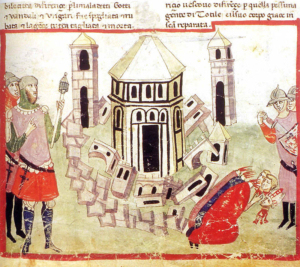
The Sacrament of Baptism and the patron of Florence, John the Baptist, call to mind the mystery that we will soon celebrate in the liturgy: the Baptism of Christ. This mystery is truly an epiphany, an event in which God manifests something of his inner life to man. Here God answers the question of Solomon, which he asked after building the Jerusalem Temple: “Is God indeed to dwell on earth? If the heavens and the highest heavens cannot contain you, how much less this house which I have built!” (1 Kgs 8:27). For indeed, John’s baptism of Christ resulted in the heavens being opened, the Spirit descending in the form of a dove, and the voice of the Father proclaiming, “This is my beloved Son, with whom I am well pleased” (Mt 3:17).
Like interwoven, polyphonic voices moving from dissonance to harmony, Christ’s Baptism resolves—brings to fulfillment—the shadowy events that prefigured his coming. The Exodus, the flood, the waters at Meribah, the crossing of the Jordan, and the dwelling in the Meeting Tent and the Temple all find their ratio in Jesus Christ. Those who enter into his baptism take part in that same resolving chord. God indeed takes up his dwelling on earth, especially in this soul baptized in this place.
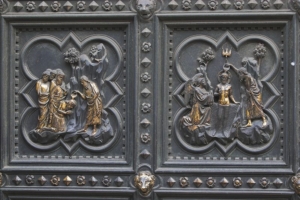
Those who enter into the Baptistery of San Giovanni enter into the mystery of Christ’s descending grace, through which the soul is adopted by the Father. The design of the building flows from faith in this invisible reality, and it attempts to enter into the same worship of the people. Heavenly realities appear before their eyes and to their ears. The iconography depicts biblical scenes, and the soaring walls and vaulted ceiling reverberate with the words of the priest and congregation. All the senses seem to be assisted by the baptistery. The work presents a beauty that overwhelms us with its fullness, escaping our grasp of why we find it so.
Architecture eludes those who live within it and those who attempt to create it. Unlike the other arts which appeal to a particular sense (music to hearing, painting to sight, etc.), architecture appeals to man’s inhabitation of time and space. When successful, as we see in the Florence baptistery, the building communicates the deepest invisible realities to our senses. The visible can never become invisible, but through the wisdom of an architect, the visible can become a translucent veil glowing with the glory of the spiritual realm. After all, this is what God intends with his creation, for his invisible, divine attributes are able to be seen through what he has made (Rm 1:20).
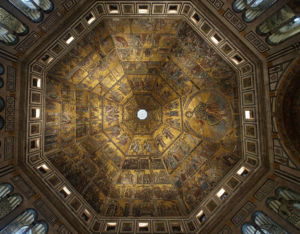
Turning our eyes to the ceiling of the baptistery, we see a bright light, the source of the glittering gold mosaics diffusing into eight panels and walls. The octagonal structure symbolizes the eight days. From one source of light comes the complete, encircling eight days of creation. As beautiful as the scene is, and as much as the sculpted space makes us long for heaven, the greater mystery lies at the floor level. There, all of heaven is poured into the soul, whether it be Dante or the Medici, or you and me. The great Architect, working through the Sacrament of Baptism, has constructed a beautiful temple in the soul.
This—I think—is the great mystery of Christ’s Baptism and the architecture of the baptistery. God completes his creation of the cosmos by making us temples of his presence.
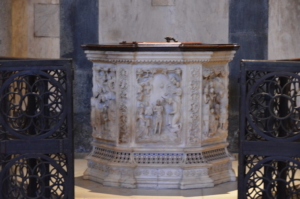
✠
Photo by Txllxt Txllxt (CC BY-SA 4.0)

